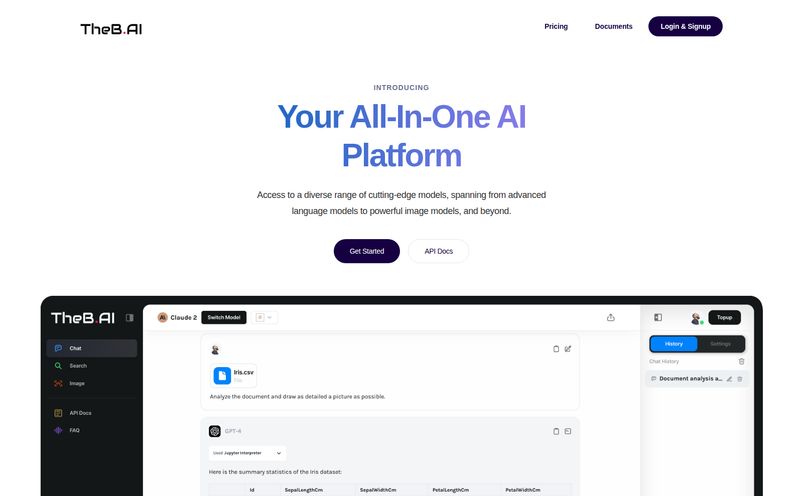If you’ve been in the web development or design game for more than a week, you know the feeling. A client slides into your DMs, excited, with a “quick project.” Attached is a 12-page PDF. Or worse, a blurry screenshot. “Can you make our site look exactly like this?” they ask. And a small part of your soul just… withers.
For years, that's been the grind. Manually re-creating layouts in Figma, painstakingly measuring pixels, and then translating it all into code that hopefully doesn't break. It's tedious. It's time-consuming. And frankly, it’s not the fun part of the job. I’ve always felt there had to be a better way.
So when I first heard about Codia AI, my professional skepticism immediately kicked in. Another AI tool promising to revolutionize my workflow? Sure, Jan. But the more I looked into it, the more I realized this might be different. It’s not just another code generator; it feels more like a universal translator for the chaotic world of digital design. And after spending some serious time with it, I have some thoughts. A lot of them.
What Exactly Is Codia AI Anyway?
Let's get this out of the way: Codia AI isn't here to take your job. Think of it less as a replacement and more as a ridiculously smart and fast assistant. At its core, Codia is a platform designed to bridge the chasm between design and development. You know, that gap where good ideas and countless hours often go to die. Its main gig is converting pretty much anything you can throw at it—screenshots, PDFs, even Canva designs—into editable Figma designs and then, the magic part, into actual front-end code.
It uses a mix of what they call Visual AI, Large Language Models (the same kind of tech behind tools like ChatGPT), and their own custom models to analyze a visual layout and understand it structurally. It sees a box with a picture and text and thinks, “Ah, that’s a product card component.” It’s this understanding that separates it from basic image-to-code converters of the past which often spat out a mess of absolute-positioned divs.

Visit Codia AI
The Features That Actually Matter
A platform is only as good as its features, and Codia comes packed. But instead of just listing them, let’s talk about the ones that made me go, “Okay, this is actually useful.”
From Static Image to Live Component with Design to Code
This is the holy grail. You have a beautiful, approved design in Figma. Now the clock starts ticking for development. Codia’s Design to Code feature is its flagship, and for good reason. It takes your Figma components and generates code in a variety of frameworks like React, Vue, and plain old HTML/CSS with Tailwind. The code it produces is surprisingly clean. It's not the jumbled, unmaintainable spaghetti code you might fear. Is it 100% perfect, copy-paste-and-deploy ready? Not always. You'll still need to be a developer and integrate it into your existing project, maybe tweak a class name here or there. But it gets you 90% of the way there in seconds. That’s a win.
The 'Screenshot to Figma' Lifesaver
Have you ever been browsing a site and thought, “Damn, I love that pricing table”? Before, my process was to screenshot it, drop it into Figma, and then manually rebuild it as a reference. It worked, but it was a chore. The Screenshot to Figma tool is a straight-up superpower. You feed it an image, and it spits out an editable Figma file with layers, text boxes, and shapes. It’s brilliant for competitor analysis, building a mood board, or just quickly iterating on an idea you saw in the wild.
Whispering Ideas into Existence with 'Prompt to UI'
Now this is where things get a little sci-fi. The Prompt to UI feature is pure generative AI. You type a description—like “a login screen for a futuristic mobile banking app with a dark theme”—and Codia generates a design concept for you directly in Figma. It's an incredible tool for brainstorming or overcoming that dreaded “blank canvas” syndrome. The results can be a fantastic starting point. They might not be your final design, but they get the creative juices flowing. Honestly, it feels like cheating in the best way possible.
Taming the Format Jungle: PDF, PSD, and Even Canva to Figma
This one is for all my fellow agency folks and freelancers. We've all received assets in formats that make our eyes twitch. A beautiful design trapped in a Photoshop file with a million disorganized layers. A layout provided as a Powerpoint slide. A Canva link. Codia's ability to convert these disparate formats (Photoshop, Illustrator, PDF, Office files, Canva) into structured Figma files is, without exaggeration, a game-changer. It saves hours of what I call “digital janitorial work”—the boring, manual rebuilding that has to happen before the real work can even start.
Let's Talk Money: Codia AI Pricing
Okay, so it sounds great, but what's the damage? I was pleasantly surprised by the pricing structure; it seems pretty well thought out for different types of users. It's not one-size-fits-all, which I appreciate.
| Plan | Price | Who It's For |
|---|---|---|
| Free | $0 | Perfect for students, educators, and freelancers just testing the waters. You get a decent number of daily AI generations and some export credits to start. You can even earn more by inviting people. No-brainer to try it out. |
| Starter | $29 /dev/month | This is the sweet spot for a solo developer or a designer who codes. You get unlimited AI generations and a generous 300 export credits per month. If you're using this regularly, this is the plan. |
| Pro | $49 /dev/month | For professional developers and small teams. The main jump here is the code export credits—you get 1000 per month. If you're building out multiple projects or have a team relying on this, the cost is easily justified by the time saved. |
| Enterprise | Contact Sales | The full package for large organizations. You get API access, custom features, and dedicated support. Standard stuff for big companies with specific needs. |
For the most up-to-date details, you should always check their official pricing page.
The Good, The Bad, and The AI-Powered
No tool is perfect, so let’s get into the nitty-gritty. The efficiency boost is real. I’m talking about cutting down the initial front-end build time for a landing page from a full day to maybe a couple of hours. That's huge. It also acts as a fantastic learning tool. A junior designer can see how their design might be structured in code, fostering a better understanding between teams.
However, it’s not a magic wand. The AI is impressive, but it’s still an AI. Sometimes it makes weird choices, or the code it exports needs a bit of refactoring to perfectly match your project’s coding standards. You still need a human with a good eye and development knowledge to guide and finalize the output. Some might argue that this reliance on AI makes developers lazy, but I disagree. I think it automates the drudgery, freeing up brainpower for more complex problem-solving, like state management and API integrations—the stuff AI can't do for you... yet.
So, Is Codia AI Worth Your Time and Money?
After all this, what’s my final verdict? Yes, for the right person, it’s absolutely worth it.
If you're a front-end developer who wants to accelerate your workflow, a full-stack dev who dreads the CSS part of the job, or a UI/UX designer who wants to hand off something more tangible than a flat design, Codia AI could easily become an indispensable part of your toolkit. The time it saves on just a couple of projects could pay for a year's subscription.
Is it for everyone? Probably not. If you're a design purist who crafts every single line of CSS by hand and enjoys that process, this might feel like sacrilege. And if you're a total beginner with no knowledge of Figma or code, there will be a learning curve. But for the vast majority of us working on the web today, tools like Codia AI are not just cool novelties; they are the future of a smarter, faster, and more creative workflow.
Frequently Asked Questions about Codia AI
- Is the code from Codia AI ready for production?
- It's very close! Think of it as production-quality boilerplate. It’s clean and well-structured, but you'll always want a human developer to review, test, and integrate it into your final application to handle logic, state, and specific project conventions.
- Do I need to be a Figma expert to use Codia AI?
- Not an expert, but having a basic understanding of Figma helps a lot. Since Codia converts things into Figma, you'll need to navigate it to make tweaks and export the code. The good news is, Figma is pretty intuitive to pick up.
- What coding languages and frameworks does it support?
- It supports a wide range of modern front-end tech, including HTML, CSS, JavaScript, React, Vue, and even mobile frameworks like Swift and Kotlin for iOS and Android development. They seem to be adding more over time.
- How does the credit system on the free plan work?
- You get a certain number of AI actions per day (like generating a design from a prompt) and a separate, smaller pool of “export credits” for converting a design to code. The daily credits reset, but the export credits are a fixed amount you get at signup, though you can earn more.
- Can Codia AI really handle a complex webpage conversion?
- For the most part, yes. It does a surprisingly good job with complex layouts. However, extremely intricate designs with lots of overlapping, transparent, or unconventional elements might require more manual cleanup in Figma after the initial conversion.
Reference and Sources
- Codia AI Official Website: https://codia.ai/
- Codia AI Pricing Page: https://codia.ai/pricing



